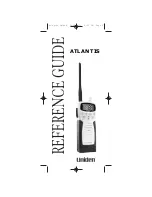
PRECAUTIONS
R
WARNING RF EXPOSURE!
This device emits
Radio Frequency (RF) energy. Extreme caution
should be observed when operating this device. If
you have any questions regarding RF exposure and
safety standards please refer to the Federal Com-
munications Commission Office of Engineering and
Technology’s report on Evaluating Compliance with
FCC Guidelines for Human Radio Frequency Electro-
magnetic Fields (OET Bulletin 65).
R
WARNING HIGH VOLTAGE! NEVER
touch an
antenna or internal antenna connector during trans-
mission. This may result in an electrical shock or burn.
R
WARNING! NEVER
operate the transceiver
while driving a vehicle. Safe driving requires your full
attention—anything less may result in an accident.
R
NEVER
apply AC power to the [DC13.8V] socket
on the transceiver rear panel. This could cause a fire
or damage the transceiver.
R
NEVER
apply more than 16 V DC, such as a 24 V
battery, to the [DC13.8V] socket on the transceiver
rear panel. This could cause a fire or damage the
transceiver.
R
NEVER
let metal, wire or other objects touch any
internal part or connectors on the rear panel of the
transceiver. This may result in an electric shock or this
could cause a fire or damege the transceiver.
R
NEVER
expose the transceiver to rain, snow or
any liquids.
DO NOT
use or place the transceiver in areas with
temperatures below –10°C (+14°F) or above +60°C
(+140°F). Be aware that temperatures on a vehicle’s
dashboard can 80°C (+176°F), resulting in
permanent damage to the transceiver if left there for
extended periods.
DO NOT
place the transceiver in excessively dusty
environments or in direct sunlight.
DO NOT
place the transceiver against walls or put
anything on top of the transceiver. This will obstruct
heat dissipation.
Place unit in a secure place to avoid inadvertent use
by children.
During mobile operation,
NEVER
place the trans-
ceiver where air bag deployment may be obstructed.
During mobile operation,
DO NOT
place the trans-
ceiver where hot or cold air blows directly onto it.
During mobile operation,
DO NOT
operate the trans-
ceiver without running the vehicle’s engine. When the
transceiver’s power is ON and your vehicle’s engine
is OFF, the vehicle’s battery will quickly become ex-
hausted.
Make sure the transceiver power is OFF before start-
ing the vehicle engine. This will avoid possible dam-
age to the transceiver by ignition voltage spikes.
During maritime mobile operation, keep the trans-
ceiver and microphone as far away as possible from
the magnetic navigation compass to prevent errone-
ous indications.
BE CAREFUL! The rear panel will become hot when
operating the transceiver continuously for long peri-
ods.
BE CAREFUL! If a linear amplifier is connected, set
the transceiver’s RF output power to less than the
linear amplifier’s maximum input level, otherwise, the
linear amplifier will be damaged.
Use Icom microphones only (supplied or optional).
Other manufacturer’s microphones have different pin
assignments, and connection to the IC-7200 may
damage the transceiver.
For U.S.A. only
Caution:
Changes or modifications to this trans-
ceiver, not expressly approved by Icom Inc., could
void your authority to operate this transceiver under
FCC regulations.
ii




































